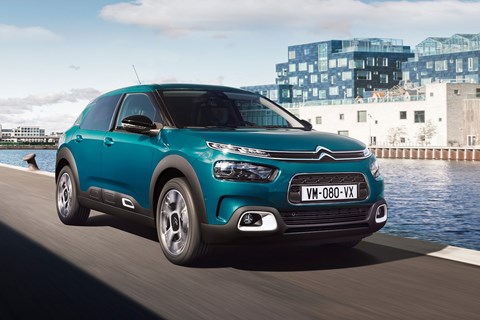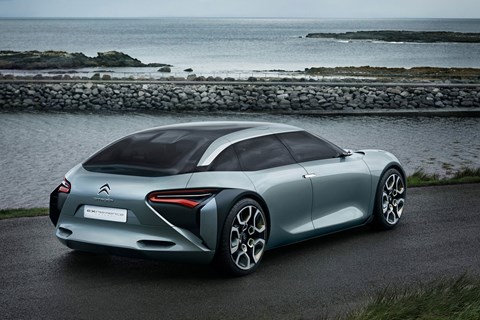► CAR chats with Linda Jackson
► Citroen CEO on new cars, 2017…
► …and what to do about Opel
Citroën’s facelifted C4 Cactus SUV is being repositioned as a midsized hatchback, to fill the gap while a more typical Volkswagen Golf rival is developed. The company’s British CEO, Linda Jackson, has explained the strategy behind stripping the C4 Cactus of its rufty-tufty Airbumps front and rear, roof bars and tailgate cladding, all functional features formerly giving the Cactus (pictured below) a pumped-up SUV demeanour.
‘With C3 Aircross coming in and C4 [hatchback] coming to the end of its life, we wanted to evolve C4 Cactus in its midlife to create a coherent range,’ Jackson said. ‘We’ve done a lot of work on design, features and comfort that will move it towards being credible in the C-segment. We’ve evolved it into a vehicle that could attract some C4 customers, though it [won’t satisfy] 100% of them.’
It’s clearly a stopgap move, and not an easy task to differentiate one 4157mm B-segment crossover with the other 4154mm B-segment crossover (C4 Cactus and C3 Aircross respectively). However, the first European application of Citroën’s Progressive Hydraulic Cushions, which replace mechanical bump stops at the end of suspension travel with hydraulic ones to absorb and dissipate kinetic energy, should make the updated Cactus’s ride comfort rival the C-segment’s best.

But the car’s compact external dimensions – even if interior space defies them – will prove a limiting factor for some. Especially as the tweaked Cactus, coming in April, is priced from £17,265 – some £3270 more than the charming C3 Aircross.
Large saloon and new hatch in development
The conundrum arose because the product plan Jackson inherited had DS models alongside Citroën ones, with the brands sometimes poised to go it alone in certain segments. But since DS was spun off as a luxury brand, Jackson’s team has to fill any gaps year-by-year, until Citroën has a range of eight standalone models. (That doesn’t include any joint-venture cars, such as the C1 city car co-produced with Toyota.)
So what’s coming next? ‘Obviously in future we need to have a C-segment hatch/saloon – it’s in the plan,’ she confirms. ‘It’s a very traditional segment, and we need to be careful about how different we are. But that’s a little bit in the future; the priority now is SUVs.’

Expect the C4 replacement to look somewhat ground-breaking: Jackson believes one of the reasons Citroën lost its way was because it started producing bland, conservative cars such as the C4 hatch and C5 saloon. On her watch, the brand is happy to take more risks, so it will be interesting to see how Citroën interprets the C-segment hatch ‘silhouette’.
The 2016 Cxperience concept’s silhouette (pictured above) indicates how Citroën is playing with bodystyles, mixing four doors, a coupe’s slanted roofline and a hatchback rump. ‘What we won’t do, whether people like it or not, is come up with something traditional,’ Jackson asserts. You can take it that the Paris show car gives big clues to the C5 replacement.
‘We will replace the C5, we want Citroën to have a large car,’ she continues. ‘We have to have one to be credible as a global manufacturer, we can’t just build small cars. Take China: saloon sales might be declining but it’s still a substantial part of the world’s biggest market.’
How was 2017 for Citroën?
Last year, Citroën grew sales by 3% in Europe: ‘we’re up 23% since 2013,’ points out Jackson, who is on track to grow global volumes by 500,000 to 1.6 million units by 2020. But overall Citroën was down 7.5%, as sales slumped 47% in China. The French brand was caught out by the Chinese embracing SUVs from homegrown car makers. But with the C5 Aircross entering the market from September and quickly shifting 25,000 units, Citroën delivered 42% of its annual Chinese volume in the final four months of the year.
The C5 Aircross (pictured below) comes to Europe in late 2018, with the smaller C3 Aircross going the other way (to China). A full year of C3 Aircross sales in the UK will help Jackson turn around last year’s 18% slide: the focus is there, with the CEO in the UK for a business review and some dealer visits. Jackson’s home market is one of the last European markets to get the baby Aircross because of right-hand drive requirements, and in the final quarter the new SUV drove 9.5% growth in mainland Europe.

It’s blindingly obvious but success depends on offering SUVs, and Citroën has now put out two fireworks and lit the blue touch paper, so expect to see some pyrotechnics during 2018-19. After all, the most popular SUVs sell 130,000 units a year. ‘Why can’t C3 Aircross achieve that as a minimum? We are geared up in all ways to support that,’ asserts Jackson. Initial sales project to 135,000 units at an annualised rate; in its best year the C3 Picasso shifted 90,000 units. And that’s the reason why manufacturers are abandoning MPVs for SUVs.
Jackson’s view on reviving Opel-Vauxhall
PSA Groupe has announced the PACE turnaround plan for new acquisition Opel-Vauxhall, focusing on engineering and manufacturing efficiencies to drive down costs, and ways to grow profits. From her experience of revitalising Citroën, Linda Jackson believes the key thing is to establish a clear brand position.
‘What is the Vauxhall [brand’s] signature? That’s probably the most important message. With Citroën, DS and Peugeot, we very clearly defined how we wanted the brands to be perceived.’

Upon becoming CEO in 2014, Jackson took her product team to Citroën’s conservatoire of heritage vehicles, to seek out the innate characteristics that could underpin the brand as it sought a revival. They alighted on comfort, eye-catching and potentially polarising design, spacious and airy interiors to make occupants feel good, and plenty of opportunities for revenue-driving personalisation – all of which have shaped her Citroën generation, the C3 hatchback and C3 and C5 Aircross SUVs.
Would Jackson object to Citroëns being built alongside Vauxhalls in the Ellesmere Port plant, which needs to make a case for its post-Brexit future? ‘Ideologically no, but most of our factories are in France or elsewhere [to serve their local markets, such as China or South America]. It’s not a matter of principle but a matter of business sense.’
Check out our Citroen reviews